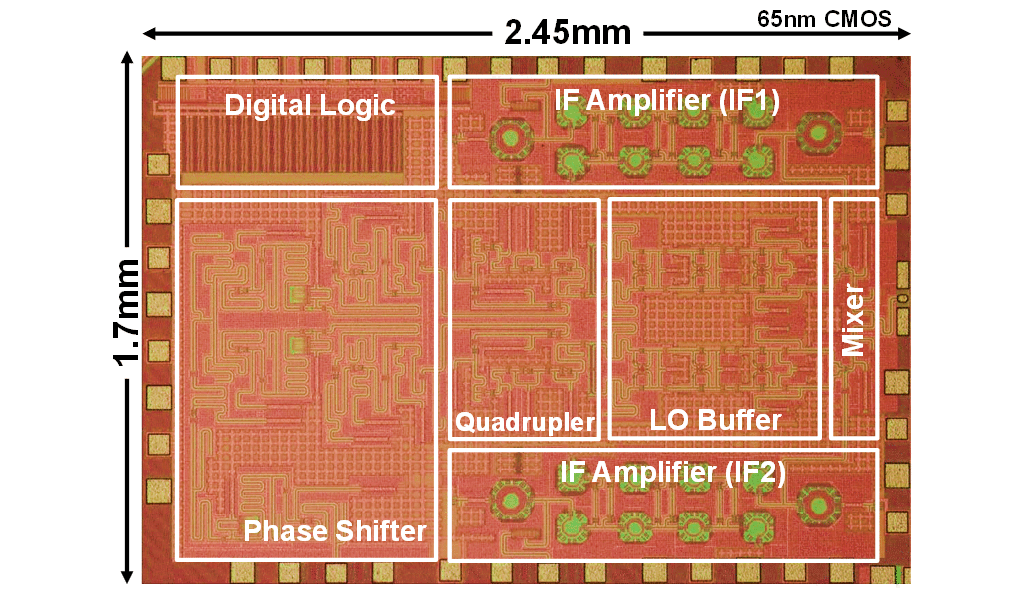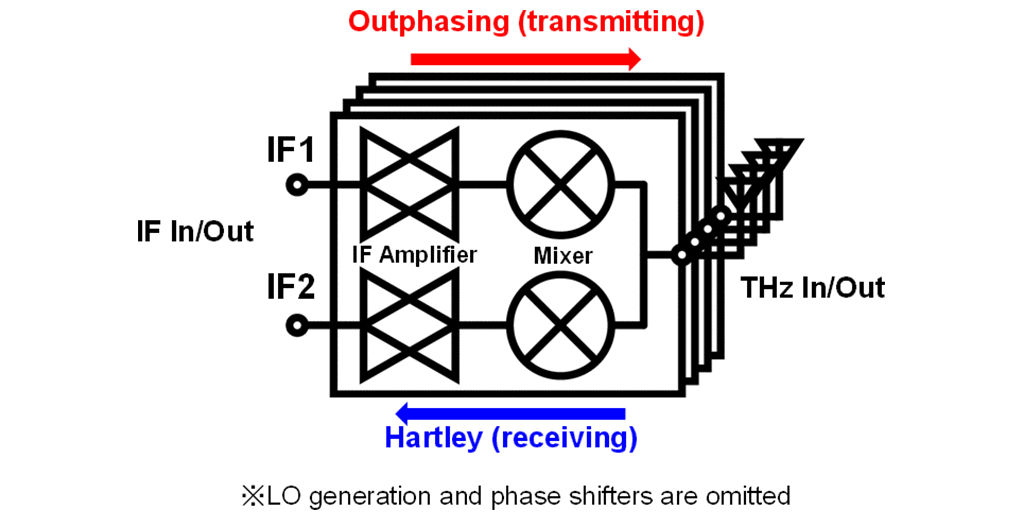Microsoft ends support for Internet Explorer on June 16, 2022.
We recommend using one of the browsers listed below.
- Microsoft Edge(Latest version)
- Mozilla Firefox(Latest version)
- Google Chrome(Latest version)
- Apple Safari(Latest version)
Please contact your browser provider for download and installation instructions.
February 5, 2021
Tokyo Institute of Technology
NTT Corporation
Pushed to the Limit: A CMOS-based transceiver for beyond 5G applications at 300 GHz
(Tokyo, February 5) Scientists at Tokyo Institute of Technology and NTT Corporation develop a novel CMOS-based transceiver for wireless communications at the 300 GHz band, enabling future beyond-5G applications. Their design addresses the challenges of operating CMOS technology at its practical limit and represents the first wideband CMOS phased-array system to operate at such elevated frequencies.
Communication at higher frequencies is a perpetually sought-after goal in electronics because of the greater data rates that would be possible and to take advantage of underutilized portions of the electromagnetic spectrum. Many applications beyond 5G, as well as the IEEE802.15.3d standard for wireless communications, call for transmitters and receivers capable of operating close to or above 300 GHz.
Unfortunately, our trusty CMOS technology is not entirely suitable for such elevated frequencies. Near 300 GHz, amplification becomes considerably difficult. Although a few CMOS-based transceivers for 300 GHz have been proposed, they either lack enough output power, can only operate in direct line-of-sight conditions, or require a large circuit area to be implemented.
To address these issues, a team of scientists from Tokyo Institute of Technology (Tokyo Tech), in collaboration with NTT Corporation (NTT), proposed an innovative design for a 300 GHz CMOS-based transceiver (Figure 1). Their work will be presented in the Digests of Technical Papers in the 2021 IEEE ISSCC (International Solid-State Circuits Conference), a conference where the latest advances in solid-state and integrated circuits are exposed.
One of the key features of the proposed design is that it is bidirectional; a great portion of the circuit, including the mixer, antennas, and local oscillator, is shared between the receiver and the transmitter (Figure 2). This means the overall circuit complexity and the total circuit area required are much lower than in unidirectional implementations.
Another important aspect is the use of four antennas in a phased array configuration. Existing solutions for 300 GHz CMOS transmitters use a single radiating element, which limits the antenna gain and the system's output power. An additional advantage is the beamforming capability of phased arrays, which allows the device to adjust the relative phases of the antenna signals to create a combined radiation pattern with custom directionality. The antennas used are stacked "Vivaldi antennas," which can be etched directly onto PCBs, making them easy to fabricate.
The proposed transceiver uses a subharmonic mixer, which is compatible with a bidirectional operation and requires a local oscillator with a comparatively lower frequency. However, this type of mixing results in low output power, which led the team to resort to an old yet functional technique to boost it. Professor Kenichi Okada from Tokyo Tech, who led the study, explains: "Outphasing is a method generally used to improve the efficiency of power amplifiers by enabling their operation at output powers close to the point where they no longer behave linearly-that is, without distortion. In our work, we used this approach to increase the transmitted output power by operating the mixers at their saturated output power." Another notable feature of the new transceiver is its excellent cancellation of local oscillator feedthrough (a "leakage" from the local oscillator through the mixer and onto the output) and image frequency (a common type of interference for the method of reception used).
The entire transceiver was implemented in an area as small as 4.17 mm2. It achieved maximum rates of 26 Gbaud for transmission and 18 Gbaud for reception, outclassing most state-of-the-art solutions. Excited about the results, Okada remarks: "Our work demonstrates the first implementation of a wideband CMOS phased-array system that operates at frequencies higher than 200 GHz." Let us hope this study helps us squeeze more juice out of CMOS technology for upcoming applications in wireless communications!
Reference
-
- Session 22.2:
- Terahertz for Communication and Sensing 8:30 AM, February 17th
-
- Session Title:
- A 300GHz-Band Phased-Array Transceiver Using Bi-Directional Outphasing and Hartley Architecture in 65nm CMOS [Technical paper are released at February 5 5:00 PM PST, Live Q &As : February 17th 8:38 AM PST]
-
- Proceedings of the 2021 IEEE ISSCC (International Solid-State Circuits Conference)
-
- Authors:
- Ibrahim Abdo1, Carrel da Gomez1, Chun Wang1, Kota Hatano1, Qi Li1, Chenxin Liu1, Kiyoshi Yanagisawa1, Ashbir Aviat Fadila1, Jian Pang1, Hiroshi Hamada2, Hideyuki Nosaka2, Atsushi Shirane1, Kenichi Okada1*
-
- Affiliations:
-
1Tokyo Institute of Technology, Tokyo, Japan
2NTT, Kanagawa, Japan

Figure 1. Chip micrograph of 300GHz-band phased-array transceiver implemented by 65nm CMOS

Figure 2. Proposed bidirectional phased-array transceiver architecture
About Tokyo Institute of Technology
Tokyo Tech stands at the forefront of research and higher education as the leading university for science and technology in Japan. Tokyo Tech researchers excel in fields ranging from materials science to biology, computer science, and physics. Founded in 1881, Tokyo Tech hosts over 10,000 undergraduate and graduate students per year, who develop into scientific leaders and some of the most sought-after engineers in industry. Embodying the Japanese philosophy of "monotsukuri," meaning "technical ingenuity and innovation," the Tokyo Tech community strives to contribute to society through high-impact research.
https://www.titech.ac.jp/english/
About NTT Corporation
NTT believes in resolving social issues through our business operations by applying technology for good. We help clients accelerate growth and innovate for current and new business models. Our services include digital business consulting, technology and managed services for cybersecurity, applications, workplace, cloud, datacenter and networks all supported by our deep industry expertise and innovation. As a top 5 global technology and business solutions provider, our diverse teams operate in 80+ countries and regions and deliver services to over 190 of them. We serve over 80% of Fortune Global 100 companies and thousands of other clients and communities around the world. For more information on NTT, visit www.global.ntt/ .
Contact
Emiko Kawaguchi
Public Relations Group,
Tokyo Institute of Technology
media@jim.titech.ac.jp
+81-3-5734-2975
Public Relations
Science and Core Technology Laboratory Group,
NTT Corporation
science_coretech-pr-ml@hco.ntt.co.jp
+81-46-240-5157
Information is current as of the date of issue of the individual press release.
Please be advised that information may be outdated after that point.
NTT STORY
WEB media that thinks about the future with NTT










